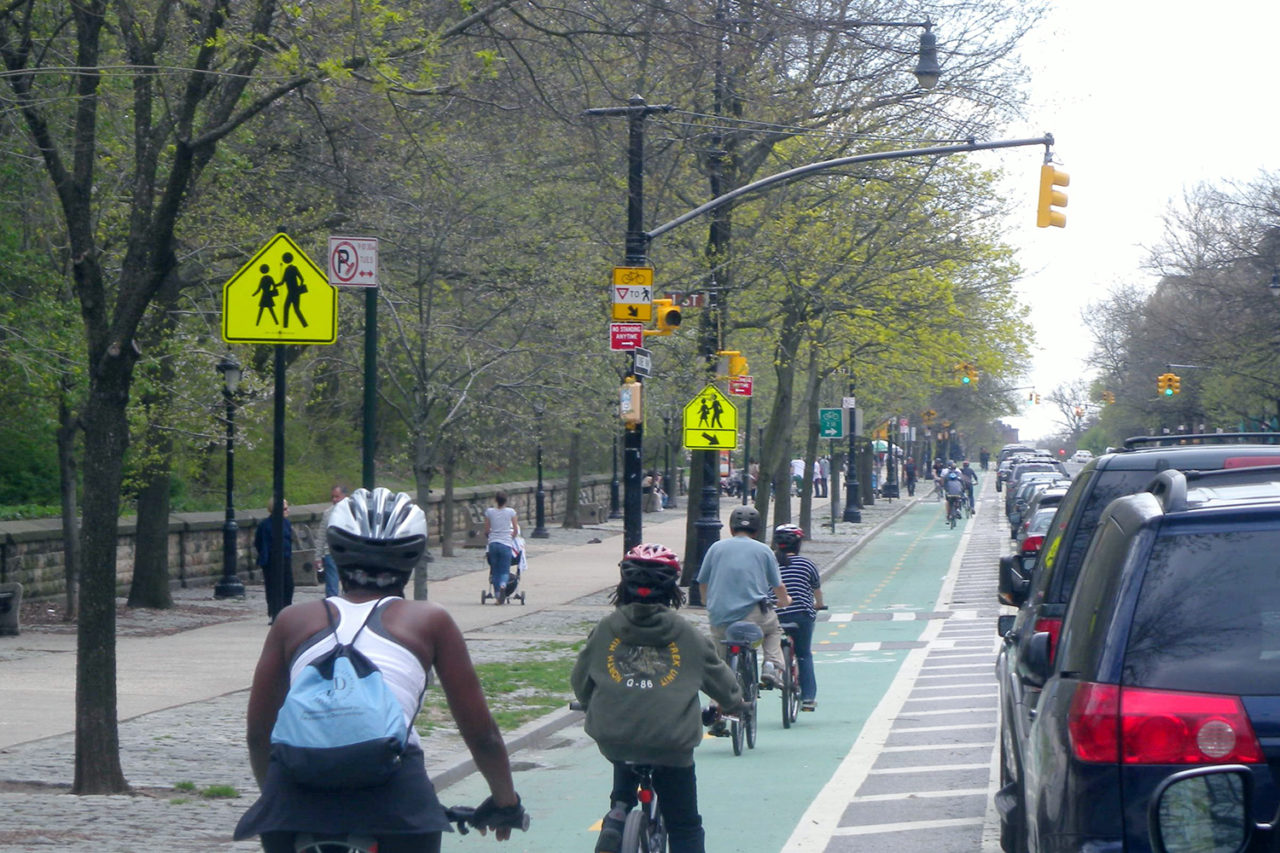by: Bradley Sherburne, Ankita Nalavade, Harriet Provine, James Piacentini, and Iyatunde Majekodunmi
On November 15, the 2022 class of nycoba|NOMA and AIANY’s Civic Leadership Program (CLP) presented their first public event of the year, “Biking in NYC Now: Opportunities and Limitations within Urban Infrastructure,” organized by Bradley Sherburne, Ankita Nalavade, Harriet Provine, James Piacentini, and Iyatunde Majekodunmi. The event, which took place at the Center for Architecture, focused on the rising importance of cycling since the start of the COVID-19 pandemic and on opportunities and limitations for cycling infrastructure in New York City through three primary lenses: equity, education, and enforcement.
COVID-19 forced us to recalibrate of most of our experiences in public space, including cycling. NYC Department of Transportation reports indicate that cycling increased over 33 percent from mid-2019 to mid-2020, and this trend only increased during the pandemic. The uptick in ridership extends across all five boroughs and across all use cases, from leisure to livelihood to commuting. The city also saw a diversification of the types and speeds of micro-mobility vehicles, including e-bikes, scooters, mopeds, and more.
However, during this same time, while the city implemented many major infrastructure improvements, changes to the built environment lagged significantly behind the increase in ridership and behavior. This imbalance has increased the risks for cyclists, but it has also set the stage for exciting opportunities to improve cycling infrastructure moving forward.
With these concerns in mind, this public event explored several complex and overlapping questions about cycling infrastructure, including: Who has access to biking infrastructure? Who is biking infrastructure built for? How are cyclists, pedestrians, and drivers educated on the proper usage of shared roads? What methods can be better utilized to ensure the safety of cyclists?
To understand these and other questions in more detail, three industry experts joined us at the Center for Architecture to discuss the past, present, and future of cycling in New York City. Inbar Kishoni, Community and Equity Programs Manager at Citi Bike; Jon Orcutt, Director of Advocacy at Bike New York; and Sean Quinn, Assistant Commissioner of Street Improvement Program at the NYC Department of Transportation, each provided unique and pertinent perspectives on how education, equity, and enforcement impact and are impacted by the physical design and implementation of the built environment.
The panel began with a conversation on how cycling has changed during the pandemic and how different sectors can work together to improve infrastructure. From there, the discussion shifted to specific topics and scenarios relating to the primary lenses of education, equity, and enforcement.
The panel highlighted several important considerations relating to cycling infrastructure improvements. The diversification of vehicle types that arose during the pandemic means that future infrastructure needs to be both more accommodating and more focused to ensure that streets are shared safely. While past infrastructure rollouts have primarily focused on connections to inner commercial cores, the future of cycling investments should aim outward toward residential sections of the city. However, while there are exciting initiatives in the works, the lack of strong coalitions and institutional and political buy-in at the city and state levels mean that building a cycling-focused city will be an uphill battle.
Despite political challenges, designers, urbanists, and architects have an incredible role to play in constructing and programming public spaces to improve the experience of cycling. This includes unpacking the complex set of uses and programs that occupy the curb and finding ways to create dynamic and responsive infrastructure and policies. Further, street design, traffic engineering, and neighborhood-level planning are crucial to increasing access to cycling infrastructure and to making that infrastructure safer and more meaningful to the daily lives of New Yorkers.
There is still much work to be done to improve access to safe cycling spaces in the city. This includes wrestling with the city’s prevalent car culture, partnering bottom-up and top-down approaches to build politically effective advocacy coalitions, and focusing investments and partnerships in neighborhoods that have not historically been included in conversations around cycling infrastructure. However, this program highlighted the important role urbanists and designers will play in engaging with these complex challenges and opportunities, pushing the conversation around safe and equitable cycling in New York City toward action.
Special thanks to:
Benjamin Prosky, Assoc. AIA, Executive Director, AIANY | Center for Architecture
Kavitha Mathew, AIA, Special Projects Director, AIANY
Suzanne Mecs, Managing Director, AIANY
Adam Roberts, Director of Policy, AIANY
Christina Brown, Architectural Designer, KPF
Anne Chen, Architect, Gensler
Lopita Das, Architectural Designer, Perkins Eastman
Sarah Kaufman, Adjunct Professor of Planning, Rudin Center for Transportation, NYU Wagner School
Karissa Lidstrand, Planning Team Lead, Pedestrian Unit, NYC Department of Transportation
Carl Sundstrom, NYC Department of Transportation
Mike Flynn, Senior Principal + National Director, Transportation Planning, Sam Schwartz
Daniel Flanzig, New York Bike Lawyers
Kathryn Prybylski, Senior Vice President, Capital Program, NYC Economic Development Corporation
Heidi Prenevost, Volunteer, Mechanical Gardens Co-op
Katie Bishop, Owner, Principles GI
Stephane Pierre, Transportation Planner, NYC Department of City Planning
Julia D Day, Team Director, Gehl
Vikki Barbero, Chair, Manhattan Community Board 5
E.J. Kalafarski, Transportation Committee Chair, Manhattan Community Board 5
Kyle Athayde, Chair, Manhattan Community Board 6
Brian Van Nieuwenhoven, Transportation Committee Chair, Manhattan Community Board 6
Charlie Todd, Manhattan Community Board 5
Andrea Kahn, Architect and Founder, designCONTENT
Luke Ohlson, Executive Director, 7Cinema
Elizabeth Adams, Senior Director for Advocacy & Organizing, Transportation Alternatives








